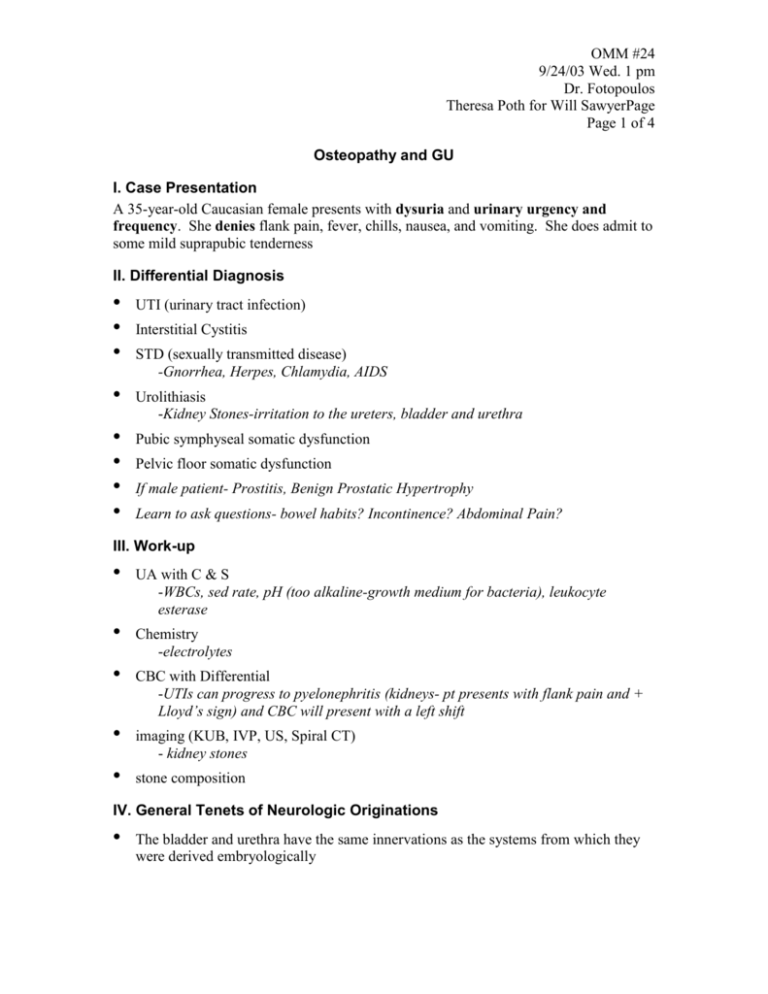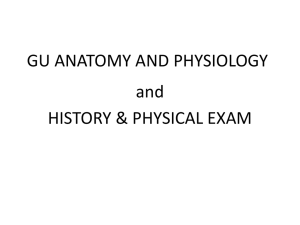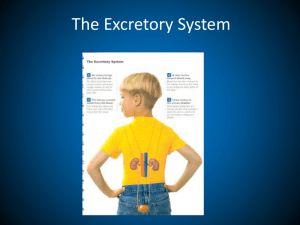Osteopathy and GU
advertisement

OMM #24 9/24/03 Wed. 1 pm Dr. Fotopoulos Theresa Poth for Will SawyerPage Page 1 of 4 Osteopathy and GU I. Case Presentation A 35-year-old Caucasian female presents with dysuria and urinary urgency and frequency. She denies flank pain, fever, chills, nausea, and vomiting. She does admit to some mild suprapubic tenderness II. Differential Diagnosis • • • • • • • • UTI (urinary tract infection) Interstitial Cystitis STD (sexually transmitted disease) -Gnorrhea, Herpes, Chlamydia, AIDS Urolithiasis -Kidney Stones-irritation to the ureters, bladder and urethra Pubic symphyseal somatic dysfunction Pelvic floor somatic dysfunction If male patient- Prostitis, Benign Prostatic Hypertrophy Learn to ask questions- bowel habits? Incontinence? Abdominal Pain? III. Work-up • • • • • UA with C & S -WBCs, sed rate, pH (too alkaline-growth medium for bacteria), leukocyte esterase Chemistry -electrolytes CBC with Differential -UTIs can progress to pyelonephritis (kidneys- pt presents with flank pain and + Lloyd’s sign) and CBC will present with a left shift imaging (KUB, IVP, US, Spiral CT) - kidney stones stone composition IV. General Tenets of Neurologic Originations • The bladder and urethra have the same innervations as the systems from which they were derived embryologically OMM #24 9/24/03 Wed. 1 pm Page 2 of 4 • • • Sphincter, trigone, and ureteral orifices are activated by the sympathetic innervations of T12-L2 (WILL SEE AGAIN) The above structures are inhibited by the parasympathetic innervations of S2-S4 -detrusor mm. (WILL SEE AGAIN) The bladder wall is activated by the parasympathetics and inhibited by the sympathetics (IMPORTANT!) V. Sympathetic (IMPORTANT) • • • • • • Sympathetics T10-L1= kidneys, ureters T12-L2= bladder Kidneys and upper ureters synapses at the superior mesenteric ganglion Preganglionic fibers for kidney and upper ureters = superior mesenteric collateral ganglion -Technique to use on these will be the ganglionic inhibition to help balance out the autonomic nervous system Lower ureters, bladder = inferior mesenteric collateral ganglion VI. Effects of Increased Sympathetic Tone • • • • • • Vasoconstriction of afferent arterioles to the kidneys Leads to decrease in GFR, and results in decreased urine volume Causes decreased ureteral peristaltic waves, and may cause ureterospasm Causes bladder wall relaxation and incomplete emptying – may lead to vesicoureteral reflux (this can happen to spinal cord injury pts.) Increased tone to external urinary sphincter Ureteral stimulation, (ie, ureteral stone) = kidney as target organ for sympathetic discharge VII. Effects of Increased Sympathetic Tone • • • Facilitates contraction of the trigone muscle Relaxation of the detrusor muscle This is necessary to allow expansion of the bladder while it is filling OMM #24 9/24/03 Wed. 1 pm Page 3 of 4 VIII. Global Effects of Renal Sympathetic Stimulation • “…experiments show when sympathetic nerves to kidneys are stimulated continuously for several weeks, renal retention of fluid occurs and causes chronically elevated arterial pressure as long as the sympathetic stimulation continues. Therefore, it is possible for nervous stimulation of the kidneys to cause chronic elevation of arterial pressure.” Guyton Textbook of Physiology (This is for all you physiologists out there!!!) IX. Parasympathetic (Important) • • Vagus • • Kidneys Proximal Ureters Pelvic Splanchnic Nerves • • Distal Ureters Bladder X. Parasympathetic • • • • Parasympathetics Kidney and proximal portion of ureters = Vagus nerve Distal portion of ureters, bladder = Pelvic Splanchnic Nerves (S2-4) In ureters they maintain normal peristaltic waves. XI. Effects of Increased Parasympathetic Tone • • • • • • Increases ureteral peristaltic waves Increases bladder wall tone (detrusor mm.) Relaxes internal urinary sphincter Excitatory to the detrusor muscle Inhibitory to the trigone muscle This allows voiding to take place XII. Effects of Decreased Parasympathetic Tone • • Decreases bladder wall tone Tightens internal urinary sphincter Notes: -Next two slides show reference diagrams OMM #24 9/24/03 Wed. 1 pm Page 4 of 4 -Appendix overlies the ureter and with a appendicitis you can get blood in the urine. The epithelial linings are swollen and allow blood from the appendix to seep through into the ureter. XIII. Lymphatics • • • Lymphatics Renal lymphatics flow into the pre-aortic nodes before traveling up the thoracic duct to the subclavian vein. (Important) Synchronous motion of the thoracic and pelvic diaphragms is vital to lymphatic drainage from the urinary system. -You want to open up the “floodgates”-open up the pelvic diaphragm, abdominal diaphragm, Sibson’s fascia, and once they are open you can pump the lymphatics. XIV. Lymphatic Drainage of the Kidneys • • Drain waste products, fluids, electrolytes, infectious products and antibiotic products to the preaortic nodes before traveling to the thoracic duct and dumping into the subclavian vein. During acute ureteral obstruction, lymph flow has been shown to increase by 300%. XV. Factors Affecting Lymphatic Flow • • Dependent upon the synchronous motion of the thoracic (active) and pelvic (passive) diaphragms Therefore, proper respiratory mechanics (ribs, thoracic spine, diaphragm excursion, unrestricted Sibson’s fascia) is vital XVI. Treatment Plan For Case Presentation • • • • Facilitated segments of kidneys and ureters (T10-L1) and bladder (T12-L2) Balance the parasympathetics by treating the sacrum (S2 – S4) and innominates and the vagus Treat the thoracics, rib cage, respiratory diaphragm, and pelvic diaphragm Treat the whole body- look at the feet( flat footed which causes poor posture) Notes: When treating the bladder area, the anterior Chapman points are going to be the periumbilical region.








